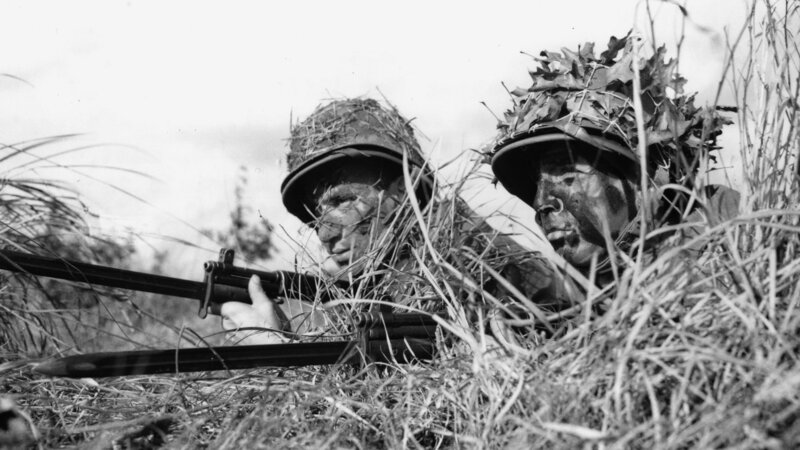10
10
0
Edited >1 y ago
Posted >1 y ago
Responses: 4
Charged with developing a new helmet, the Infantry Board wisely tackled the problems of both helmet and suspension system concurrently. In a report on the helmet the board stated: “Research indicated that the ideal shaped helmet is one with a dome-shaped top following the full contour of the head and supplying uniform headroom for indentation, extending down the front to cover the forehead without impairing vision and down the sides as far as possible to be compatible with the rifle, etc., and down the back as far as possible without pushing the helmet forward when in a prone position, and with a frontal plate flanged forward as a cap-style visor and the sides and rear flanged outward to deflect rain from the collar opening. Following these requirements, the designers simply took the M1917A1, acceptable for protecting the top of the head, cut off the brim and added the sides and the front and back flanges.
The addition of a removable insert worn between head and helmet first appeared in 1932 during tests of the failed 5A. In 1940, the Army designers, at the suggestion of General George Patton, turned to the American playing field, borrowing the Riddell suspension system invented and patented by John T. Riddell, owner of a Chicago football supply manufacturing company. The Army Ordnance Department created a plastic impregnated fiber liner containing the Riddell suspension system. Covered with an olive drab cloth and fitted with an adjustable headband, the liner slipped snugly inside the helmet. In February 1941, the Infantry Board reported favorably on the first test helmet with liner designated the TS-3 (Test Section model 3).
The helmet’s outer shell, made of the same Hadfield manganese steel used in the doughboy helmet, acquired new specifications. Tests at the Aberdeen Proving Ground indicated the new helmet “would resist penetration by a 230-grain caliber .45 bullet with a velocity of 800 f.p.s,” an improvement over the old helmet’s resistance to a .45 bullet at 600 f.p.s. The steel outer shell weighed 2.3 pounds, and the liner seven-tenths of a pound for a total of 3 pounds. On April 30, the helmet was standardized, and on June 9, approved as “Helmet, Steel, M1.” The Ordnance Department supervised the procurement and development of the outer shell, while the Quartermaster Department managed the development and production progress of the liner and suspension device. The first contract for the helmets went to the McCord Radiator Company of Detroit, Michigan.
The addition of a removable insert worn between head and helmet first appeared in 1932 during tests of the failed 5A. In 1940, the Army designers, at the suggestion of General George Patton, turned to the American playing field, borrowing the Riddell suspension system invented and patented by John T. Riddell, owner of a Chicago football supply manufacturing company. The Army Ordnance Department created a plastic impregnated fiber liner containing the Riddell suspension system. Covered with an olive drab cloth and fitted with an adjustable headband, the liner slipped snugly inside the helmet. In February 1941, the Infantry Board reported favorably on the first test helmet with liner designated the TS-3 (Test Section model 3).
The helmet’s outer shell, made of the same Hadfield manganese steel used in the doughboy helmet, acquired new specifications. Tests at the Aberdeen Proving Ground indicated the new helmet “would resist penetration by a 230-grain caliber .45 bullet with a velocity of 800 f.p.s,” an improvement over the old helmet’s resistance to a .45 bullet at 600 f.p.s. The steel outer shell weighed 2.3 pounds, and the liner seven-tenths of a pound for a total of 3 pounds. On April 30, the helmet was standardized, and on June 9, approved as “Helmet, Steel, M1.” The Ordnance Department supervised the procurement and development of the outer shell, while the Quartermaster Department managed the development and production progress of the liner and suspension device. The first contract for the helmets went to the McCord Radiator Company of Detroit, Michigan.
(6)
(0)
Drill Sergeants liked to take sign and bank on my helmet when I didn't follow instruction on rifle range.. Rapid fire I was taking my time hitting all the targets sergeant puts finger on my trigger pulls it fast. M14 bouncing off my shoulder. Know do you know what rapid fire is he yells. Bruse for a while. LOL
(3)
(0)
Read This Next



 WWII World War Two
WWII World War Two Military History
Military History Equipment
Equipment


